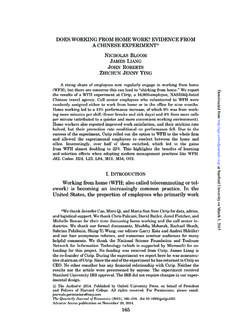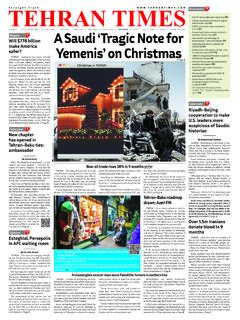Transcription of Why Working From Home Will Stick - Stanford University
1 Why Working From home Will Stick Jose Maria Barrero,* Nicholas Bloom, and Steven J. Davis January 21st 2021 Abstract: We survey 22,500 Americans over several waves to investigate whether, how, and why Working from home will Stick after COVID-19. The pandemic drove a mass social experiment in which nearly half of all paid hours were provided from home between May and December 2020. Our survey evidence says that about 22 percent of all full workdays will be supplied from home after the pandemic ends, compared with just 5 percent before. We provide evidence on five mechanisms behind this persistent shift to Working from home : better-than-expected experiences Working from home , investments in physical and human capital enabling Working from home , diminished stigma, reluctance to return to pre-pandemic activities, and innovation supporting Working from home . We also examine some implications of a persistent shift in Working arrangements: First, high-income workers, especially, will enjoy the perks of Working from home .
2 second , we forecast that the post-pandemic shift to Working from home will lower worker spending in major city centers by 5 to 10 percent. Third, many workers report being more productive at home than on business premises, so post-pandemic work from home plans offer the potential to raise productivity as much as percent. Contact: JEL No. D13, D23, E24, J22, G18, M54, R3 Keywords: COVID, Working -from- home Acknowledgements: We thank Stanford University , the University of Chicago Booth School of Business, Asociaci n Mexicana de Cultura , the Stanford Institute for Human-Centered Artificial Intelligence and Toulouse Network for Information Technology for financial support. We are grateful to comments from presentations at ITAM, HAI, LSE, Maryland, Munich, Rice, Ridge, Princeton, Stanford and the World Bank. We thank Corinne Stephenson for help generating our WFH media data. * Instituto Tecnol gico Aut nomo de M xico Stanford University University of Chicago Booth School of Business and Hoover Institution 1 1) Introduction Working from home (also called remote work or telecommuting, but hereafter referred to as WFH ) was already growing before the COVID-19 pandemic.
3 In the United States the proportion of employees who primarily worked from home had grown from in 1980 to in 2010 (Mateyka et al. 2012) and in 20181. At the same time, the wage discount (after controlling for observables) from primarily Working at home had fallen from 30% in 1980 to a wage premium of about 5% by 2017 (Pabilonia and Vernon, 2020). But the COVID-19 pandemic produced a step-increase in WFH. In independently conducted surveys, Bick, Blandin, and Mertens (2020) and Brynjolfsson et al. (2020) find that about half of all employed persons worked entirely or partly from home in May 2020. By our own estimates, about half of all paid hours were provided from home between May and October 2020, a ten fold-increase from pre-pandemic numbers. This mass experiment in Working from home has, understandably, attracted tremendous interest. The frequency of newspaper articles that mention Working from home in the Newsbank archive of around 2,000 daily US newspapers rose 120-fold (12,000%) in March relative to January 2020.
4 This explosion in interest reflects the many questions raised by a massive shift in Working arrangements and where work happens during the COVID-19 pandemic. There appears to be less consensus, however, about how well Working from home has worked, whether it will Stick after the pandemic ends, and why or why not. This lack of consensus is evident in the wide range of views, from extremely negative to extremely positive, prominent executives have expressed about Working from home . At one end of the spectrum, Netflix CEO Reed Hastings, recently said, I don't see any positives. Not being able to get together in person, particularly internationally, is a pure negative (Cutter, 2020). At the other extreme, Heyward Donigan, CEO of retailer Rite Aid, reported, We have adapted to work-from- home unbelievably We ve learned that we can work remote, and we can now hire and manage a company remotely (Cutter, 2020).
5 Others have expressed intermediate views, for example Apple CEO Tim Cook: In all candor, it s not like being together [But] I don t believe that we ll return to the way we were because we ve found that there are some things that actually work really well virtually (Cutter 2020). 1 Defined as those Working 3+ full paid days a week from home in Bureau of Labor Statistics (2018). 2 Our goal in this paper is to move past these anecdotal accounts and gather systematic evidence about whether, how, and why Working from home will Stick after the COVID-19 pandemic. We survey 22,500 Working -age Americans over several waves between May and November 2020, asking about their Working status during the pandemic, their views about Working from home , as well as their employers plans with regards to Working from home after the pandemic. Other survey questions help us examine what persistently high levels of Working from home mean for workers, for dense cities like New York and San Francisco, and for productivity.
6 We have also talked to dozens of managers and CEOs across the US to supplement this with richer discussion data. Our analysis first describes the state of Working from home during the COVID-19 pandemic. The left panel of Figure 1 shows 42 percent of Working age persons were Working from home in May 2020 at the height of pandemic lockdowns, or 62 percent among those who were Working for pay. These numbers are comparable to other estimates from early on in the pandemic, including Bick et al. (2020) and Brynjolfsson et al. (2020). In December 2020, our most recent survey wave, 36 percent of respondents, or 50 percent of persons Working for pay, were still Working from home . While lower than in May, the share of full paid Working days spent Working from home was still eight times larger in December than before the pandemic, based on data from the 2017-2018 American Time Use Survey ( see the Bureau of Labor Statistics (2018)). After the pandemic, workers report their employers are planning for them to spend about 22 percent of all paid days Working from home .
7 This arises from the approximately 50% of employees that can work from home being allowed to work from home two days a week post-pandemic. Employers mention concerns around innovation, culture and motivation as key reasons to have all employees come onto the business premises three days per week, but they are happy to have employees to spend the other two days per week Working from home . This 22 percent of days post pandemic WFH figure implies less Working from home than during the pandemic, but almost three-quarters of the drop comes from a reduction in the intensive margin. That is, many workers who during the pandemic work from home full time will move to Working from home for two to three days a week post pandemic. Our 22 percent forecast is almost five times larger than in the pre-pandemic time use data, but still half as large as what workers want in a post-pandemic world. We then turn to the question of why Working from home will Stick .
8 Our survey evidence points to five key channels. Our findings are complementary to other analyses, including research by 3 Jerbashian and Vilalta-Bufi s (2020) on how the prices of information and communication technologies impact Working from home . First, the pandemic forced workers and firms to experiment with Working from home en masse, giving them a chance to learn how well it actually works. The ubiquity of the pandemic facilitated this experimentation by allowing firms to evaluate Working from home while their clients and suppliers also worked from home . Our survey reveals that the experience has been positive and better than expected for the majority of firms and workers, consistent with survey responses from US hiring managers in Ozimek (2020). Thus, the pandemic has helped workers and organizations overcome inertia related to the costs of experimentation, as well as inertia stemming from biased expectations about Working from home .
9 In this regard, our evidence relates to the classic multi-armed bandit problem in that COVID-19 compelled firms to experiment with a new production mode Working from home and acquire information that leads some of them to Stick with the new mode after the forcing event ends. second , our survey reveals that the average worker has invested over 14 hours and about $600 dollars in equipment and infrastructure at home to facilitate Working from home . We estimate these investments amount to percent of GDP. In addition, firms have made sizable investments in back-end information technologies and equipment to support Working from home . Thus, after the pandemic, workers and firms will be positioned to work from home at lower marginal costs due to recent investments in tangible and intangible capital. Third, reduced stigma. A large majority of respondents report perceptions about Working from home have improved since the start of the pandemic among people they know.
10 With fewer people viewing Working from home as shirking from home , workers and their employers will be more willing to engage in it. Fourth, about 70 percent of our survey respondents express a reluctance to return to some pre-pandemic activities even when a vaccine for COVID-19 becomes widely available, for example riding subways and crowded elevators, or dining indoors at restaurants. This persistent fear of proximity to others is likely to leave some residual demand for social distancing at workplaces and prop up demand for Working from home in the coming years. Fifth, the rate of innovation around technologies that facilitate Working from home appears to have accelerated, as documented by Bloom, Davis, and Zhestkova (2020). Consistent with ideas from the literature on directed technical change ( , Acemoglu 2002), the massive expansion in 4 Working from home has boosted the market for Working from equipment, software and technologies, spurring a burst of research and innovation to support Working from home , in particular, and remote interactivity, more broadly.






